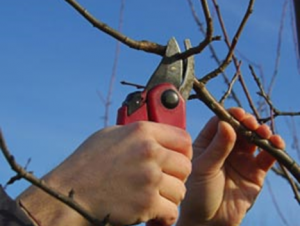Now is the time to dust off your pruners and start those late winter pruning chores. Late winter is the time many plants in the landscape are pruned before new growth begins in the spring. February is usually the best month to complete these pruning chores.
When it comes to what you can prune in February, here is a list of plants: blueberries, crape myrtles, fruit trees, muscadine grapes, ornamental grasses, roses and summer-flowering shrubs. Summer-flowering shrubs would include ones like abelia, butterfly bush, hibiscus, lantana, ligustrum, nandina, photinia and waxmyrtles.
There is one group of plants that you do NOT want to prune now. Do not prune any spring-flowering shrubs and trees. Since they have already set this year’s flower buds, pruning now would remove their spring show of blooms. Spring-flowering shrubs and trees to not prune now would include: azalea, dogwood, forsythia, saucer magnolia, quince and viburnum. Instead prune these spring-blooming plants after they finish flowering in the spring but prune them before late July before they start setting next year’s flower buds.
Pruning techniques for these plants can vary some, so you have to remember what purpose the plant serves in order to know how to prune it. For landscape plants like crape myrtles, ornamental grasses, roses, and summer-flowering shrubs their purpose is to provide flowers and beauty to the landscape. So when pruning you want to maintain an attractive shape and to have a nice display of flowers.
For blueberries, fruit trees, and grapevines the pruning techniques differ some in that you are training the plant to result in good fruit production. You want a plant that has a strong main trunk or base in order to support the plant and fruit. Branches should be spaced out to allow the plant to intercept as much sunlight as possible. Full sunlight is needed for good fruit production.
As when pruning any plant, you should always first start with removing the three D’s: dead, dying, and diseased branches. Next eliminate any crossing branches, even if the branches are not yet touching each other. Crossing branches can eventually touch each other which will allow for the branches to rub and open wounds that can allow access for disease and insects into the tree. Remove branches that are growing toward the center of the tree canopy or growing downward, instead of upward and outward from the tree’s center.
When pruning, there are a few pruning tools which all home gardeners should have. A pair of hand pruners is used for small branches 1” or less in diameter. There are two types of hand pruners. The by-pass hand pruners allow you to make very close cuts and would be used to majority of hand pruning cuts. The anvil-style hand pruners are used in a few cases where one would need to cut succulent or tender growth. A second pruning tool needed would be a pair of loppers with the ability to cut 1 to 2” branches. Lastly, a pruning saw or bow saw can be used for branches larger than 2” in diameter.
Pruning can be a big chore in late winter but with some understanding of when and how to prune, plants will be more structurally sound and attractive in your landscape and gardens.
Jessica Strickland is an Agriculture Extension Agent, specializing in horticulture for North Carolina Cooperative Extension in Wayne County.

(Photo Credit: plants.ces.ncsu.edu)

